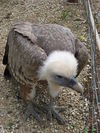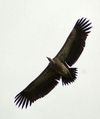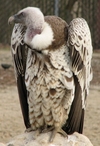Genus Gyps

White-backed Vulture - The White-backed Vulture is a typical vulture, with only down feathers on the head and neck, very broad wings and short tail feathers. It has a white neck ruff. The adult’s whitish back contrasts with the otherwise dark plumage. Juveniles are largely dark. This is a medium-sized vulture; its body mass is 4.2 to 7.2 kilograms , it is 94 cm long and has a 218 cm wingspan.
Indian White-backed Vulture - The Indian White-rumped Vulture is an Old World vulture in the family Accipitridae. It is closely related to the European Griffon Vulture . At one time it was believed to be closer to the White-backed Vulture of Africa and was known as the Oriental White-backed Vulture. The species was present in large numbers, in Southern and Southeastern Asia until the 1990s.
Cape Vulture - This vulture is dark brown except for the pale wing coverts. The adult is paler than the juvenile, and its underwing coverts can appear almost white at a distance. The average length is about 1 m with a wingspan of about 2.4 m and a body weight of 9.4 kg . They are on average the largest raptor in Africa, although they are subservient to the powerful Lappet-faced Vulture.
Griffon Vulture - The Griffin Vulture is 93–110 cm long with a 230–269 cm wingspan, and it weighs between 6 and 13 kg . Hatched naked, it is a typical Old World vulture in appearance, with a very white bald head, very broad wings and short tail feathers. It has a white neck ruff and yellow bill. The buff body and wing coverts contrast with the dark flight feathers.
Himalayan Griffon - Adults are 103-110 cm long, have a wingspan of 260-289 cm across the wings and weigh 8–12 kg . They are the second largest Old World vulture, behind only the Cinereous Vulture in size.
Indian Vulture - The Indian Vulture is an Old World vulture and is closely related to the Griffon Vulture, G. fulvus. It breeds mainly on crags in the hills of Sind in Pakistan, central and peninsular India. The birds in the northern part of its range once considered a subspecies are now considered a separate species, the Slender-billed Vulture Gyps tenuirostris. These were lumped together under the name Long-billed Vulture.
Rueppell's Griffon - Adults are close to 1 metre in length, with a wingspan of around 2.6 metres , and a weight that usually ranges from 7 to 9 kg . Both sexes are alike: mottled brown or black overall with a whitish-brown underbelly and thin, dirty-white fluff covering the head and neck. The base of the neck has a white collar, the eye is yellow or amber, the crop patch deep chocolate-brown. Silent as a rule, they become vocal at the nest and when at a carcass, squealing a great deal.
Long-billed Vulture - The Slender-billed Vulture is a recently recognized species of Old World vulture. For some time, it was categorized with its relative, the Indian Vulture, under the name of "Long-billed Vulture". However, these two species have non-overlapping distribution ranges and can be immediately told apart by trained observers, even at considerable distances. The Indian Vulture is found only to the south of the Ganges and breeds on cliffs while the Slender-billed Vulture is found along the Sub-Himalayan regions and into Southeast Asia and nests in trees.








